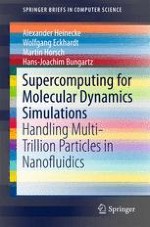This work presents modern implementations of relevant molecular dynamics algorithms using ls1 mardyn, a simulation program for engineering applications. The text focuses strictly on HPC-related aspects, covering implementation on HPC architectures, taking Intel Xeon and Intel Xeon Phi clusters as representatives of current platforms. The work describes distributed and shared-memory parallelization on these platforms, including load balancing, with a particular focus on the efficient implementation of the compute kernels. The text also discusses the software-architecture of the resulting code.
